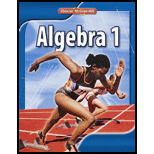
Concept explainers
(a)
List the five terms
(a)
Answer to Problem 24PPS
The first five terms of arithmetic sequence are − 3, − 1, 1, 3 and 5.
Explanation of Solution
Given:
The points on the graph are (1, − 3); (2, − 1); (3, 1); (4, 3); (5, 5)
Concept Used:
The points on the graph are (1, − 3); (2, − 1); (3, 1); (4, 3); (5, 5).
Because the terms are the second coordinate (y − coordinate) in each coordinate pair.
The terms of arithmetic sequence are − 3, − 1, 1, 3 and 5.
Calculation:
The points on the graph are (1, − 3); (2, − 1); (3, 1); (4, 3); (5, 5)
The first five terms of arithmetic sequence are − 3, − 1, 1, 3 and 5.
Thus, the first five terms of arithmetic sequence are − 3, − 1, 1, 3 and 5.
(b)
Write the formula for the nth term.
(b)
Answer to Problem 24PPS
Explanation of Solution
Given:
The points on the graph are (1, − 3); (2, − 1); (3, 1); (4, 3); (5, 5)
Concept Used:
The first five terms of arithmetic sequence are − 3, − 1, 1, 3 and 5.
Find the common difference and find the nth term of the sequence.
Calculation:
Find the common difference:
Write the equation for the nth terms of an arithmetic sequence by using the first term − 3 and common difference 2.
So, the formula for the nth terms of the arithmetic sequence is
Thus, the formula for the nth terms of the arithmetic sequence is
(c)
Write the function.
(c)
Answer to Problem 24PPS
Explanation of Solution
Given:
The points on the graph are (1, − 3); (2, − 1); (3, 1); (4, 3); (5, 5)
Concept Used:
The first five terms of arithmetic sequence are − 3, − 1, 1, 3 and 5.
The nth terms of the arithmetic sequence is
Formula for the nth term of the sequence is the function.
Thus, the function is
Chapter 3 Solutions
Algebra 1
Additional Math Textbook Solutions
Basic Business Statistics, Student Value Edition
A First Course in Probability (10th Edition)
Calculus: Early Transcendentals (2nd Edition)
Pre-Algebra Student Edition
College Algebra with Modeling & Visualization (5th Edition)
University Calculus: Early Transcendentals (4th Edition)
- In simplest terms, Sketch the graph of the parabola. Then, determine its equation. opens downward, vertex is (- 4, 7), passes through point (0, - 39)arrow_forwardIn simplest way, For each quadratic relation, find the zeros and the maximum or minimum. a) y = x 2 + 16 x + 39 b) y = 5 x2 - 50 x - 120arrow_forwardIn simplest terms and step by step Write each quadratic relation in standard form, then fi nd the zeros. y = - 4( x + 6)2 + 36arrow_forward
- In simplest terms and step by step For each quadratic relation, find the zeros and the maximum or minimum. 1) y = - 2 x2 - 28 x + 64 2) y = 6 x2 + 36 x - 42arrow_forwardWrite each relation in standard form a)y = 5(x + 10)2 + 7 b)y = 9(x - 8)2 - 4arrow_forwardIn simplest form and step by step Write the quadratic relation in standard form, then fi nd the zeros. y = 3(x - 1)2 - 147arrow_forward
- Step by step instructions The path of a soccer ball can be modelled by the relation h = - 0.1 d 2 + 0.5 d + 0.6, where h is the ball’s height and d is the horizontal distance from the kicker. a) Find the zeros of the relation.arrow_forwardIn simplest terms and step by step how do you find the zeros of y = 6x2 + 24x - 192arrow_forwardStep by step Find the zeros of each quadratic relation. a) y = x2 - 16xarrow_forward
- In simplest step by step terms, how do you find the zeros of y = x2 - 16arrow_forwardIn simplest terms, Describe the shape and position of the parabola relative to the graph of y = x 2 y = - 80( x + 9) 2 + 10.8arrow_forwardas a Identify each equation Parabola, circle, ellipse perbola without completio the square. x²-6x-14 y = 33-y² 14y ofarrow_forward
 Algebra and Trigonometry (6th Edition)AlgebraISBN:9780134463216Author:Robert F. BlitzerPublisher:PEARSON
Algebra and Trigonometry (6th Edition)AlgebraISBN:9780134463216Author:Robert F. BlitzerPublisher:PEARSON Contemporary Abstract AlgebraAlgebraISBN:9781305657960Author:Joseph GallianPublisher:Cengage Learning
Contemporary Abstract AlgebraAlgebraISBN:9781305657960Author:Joseph GallianPublisher:Cengage Learning Linear Algebra: A Modern IntroductionAlgebraISBN:9781285463247Author:David PoolePublisher:Cengage Learning
Linear Algebra: A Modern IntroductionAlgebraISBN:9781285463247Author:David PoolePublisher:Cengage Learning Algebra And Trigonometry (11th Edition)AlgebraISBN:9780135163078Author:Michael SullivanPublisher:PEARSON
Algebra And Trigonometry (11th Edition)AlgebraISBN:9780135163078Author:Michael SullivanPublisher:PEARSON Introduction to Linear Algebra, Fifth EditionAlgebraISBN:9780980232776Author:Gilbert StrangPublisher:Wellesley-Cambridge Press
Introduction to Linear Algebra, Fifth EditionAlgebraISBN:9780980232776Author:Gilbert StrangPublisher:Wellesley-Cambridge Press College Algebra (Collegiate Math)AlgebraISBN:9780077836344Author:Julie Miller, Donna GerkenPublisher:McGraw-Hill Education
College Algebra (Collegiate Math)AlgebraISBN:9780077836344Author:Julie Miller, Donna GerkenPublisher:McGraw-Hill Education





